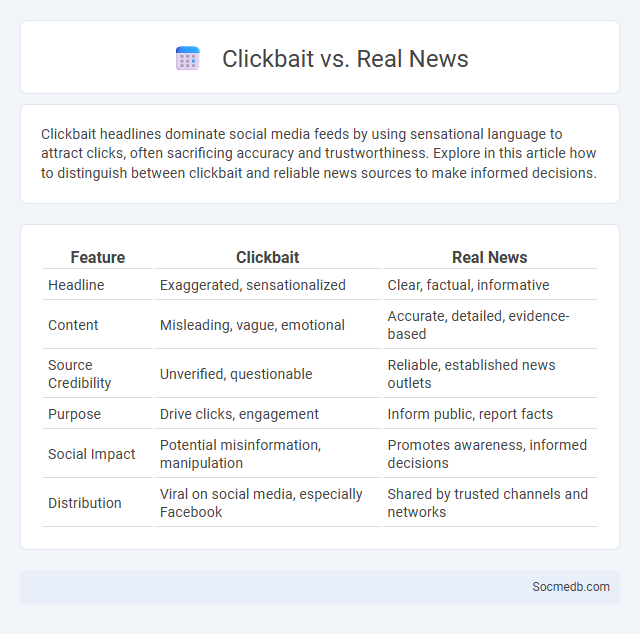
Photo illustration: Clickbait vs real news
Clickbait headlines dominate social media feeds by using sensational language to attract clicks, often sacrificing accuracy and trustworthiness. Explore in this article how to distinguish between clickbait and reliable news sources to make informed decisions.
Table of Comparison
| Feature | Clickbait | Real News |
|---|---|---|
| Headline | Exaggerated, sensationalized | Clear, factual, informative |
| Content | Misleading, vague, emotional | Accurate, detailed, evidence-based |
| Source Credibility | Unverified, questionable | Reliable, established news outlets |
| Purpose | Drive clicks, engagement | Inform public, report facts |
| Social Impact | Potential misinformation, manipulation | Promotes awareness, informed decisions |
| Distribution | Viral on social media, especially Facebook | Shared by trusted channels and networks |
Understanding Clickbait: Definition and Characteristics
Clickbait refers to online content designed to attract clicks by using sensationalized or misleading headlines that often exaggerate the actual information. These headlines exploit curiosity gaps, using phrases like "You won't believe" or "Shocking truth," which entice users to engage but frequently lead to disappointing or irrelevant content. Understanding these characteristics helps you critically evaluate social media posts and avoid falling victim to manipulative tactics that prioritize clicks over accurate information.
Real News Explained: Standards and Ethics
Real news on social media adheres to strict standards and ethics, emphasizing accuracy, transparency, and accountability to combat misinformation. Journalistic principles such as fact-checking, source verification, and unbiased reporting ensure credible content reaches audiences. Platforms implementing these ethical standards foster trust and promote informed public discourse.
Clickbait vs Real News: Key Differences
Clickbait headlines exaggerate facts or promise sensational content to attract clicks, often leading to misleading or false information. Real news prioritizes accuracy, verified sources, and balanced reporting to provide trustworthy information that informs your decisions. Understanding these key differences helps you discern credible content from manipulative tactics on social media platforms.
How Clickbait Headlines Manipulate Readers
Clickbait headlines manipulate readers by exploiting emotional triggers and curiosity gaps to drive clicks, often at the expense of content accuracy. They use sensational language, misleading claims, and exaggerated promises to capture attention and increase engagement metrics such as click-through rates. This tactic distorts information consumption, leading to misinformation spread and reduced trust in social media platforms.
Impact of Clickbait on Public Trust in Media
Clickbait headlines severely undermine public trust in media by prioritizing sensationalism over accurate reporting, leading to widespread misinformation and skepticism. Your ability to discern credible sources diminishes as these misleading tactics exploit emotional triggers to drive clicks rather than convey factual content. Over time, this erosion of trust compromises the media's role as a reliable informant in democratic societies.
Identifying Authentic News Sources
Identifying authentic news sources on social media requires verifying the credibility of the publisher, cross-checking information with reputable news organizations, and scrutinizing the author's expertise and affiliations. Key indicators include domain authority, transparent editorial standards, and consistent fact-based reporting recognized by institutions like the Reuters Institute. Leveraging tools like fact-checking websites such as Snopes and PolitiFact helps to mitigate misinformation and confirm the legitimacy of shared content.
The Rise of Clickbait in Digital Journalism
The rise of clickbait in digital journalism has transformed content strategies by prioritizing sensational headlines that maximize user engagement and ad revenue. This shift often compromises journalistic integrity, as misleading or exaggerated titles attract more clicks despite yielding lower-quality information. Platforms like Facebook and Google respond to user behavior by amplifying clickbait content, amplifying its prevalence in the digital media ecosystem.
How to Spot Clickbait vs Real News
Clickbait headlines often use sensational language, exaggerated claims, or urgent calls to action to lure clicks, while real news headlines provide clear, straightforward summaries of the content. Authentic sources typically include verifiable facts, credible author information, and links to original evidence rather than relying on emotional manipulation or vague promises. Checking multiple trusted news outlets and fact-checking websites can help discern genuine news from misleading clickbait.
Effects of Clickbait on Information Quality
Clickbait headlines often degrade information quality by prioritizing sensationalism over accuracy, leading to misinformation and reduced audience trust. This practice increases engagement through misleading content, resulting in distorted perceptions and challenges in verifying facts. Consequently, the prevalence of clickbait compromises the integrity of online information ecosystems and hampers informed decision-making.
The Future of News: Balancing Engagement and Integrity
Social media platforms are rapidly evolving as primary news sources, challenging traditional journalism by prioritizing engagement metrics like clicks and shares. To maintain your trust and uphold journalistic integrity, these platforms must implement robust fact-checking algorithms and promote transparent content curation. Striking a balance between captivating audiences and delivering accurate information is essential for the future of news in the digital age.
 socmedb.com
socmedb.com